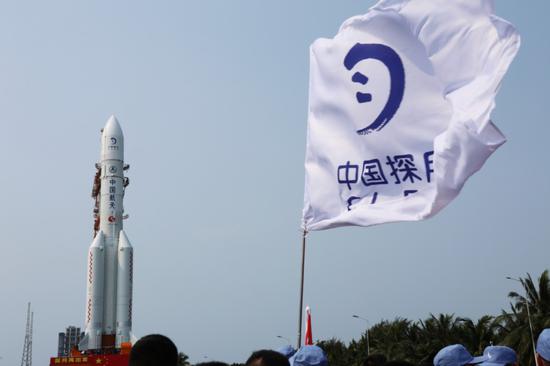 The Chang'e 6 probe atop a Long March 5 carrier rocket is transported to the launch site in Wenchang, Hainan province. (Photo/Provided to chinadaily.com.cn) The Chang'e 6, China's next robotic spacecraft to the moon, has been scheduled to set out on its journey in the coming days, tasked with bringing back samples from the silver celestial body's little-known far side, according to the China National Space Administration. A Long March 5 carrier rocket, with the 8.2-metric-ton Chang'e 6 probe on top of it, was vertically moved on Saturday morning to its launch service tower at the Wenchang Space Launch Center in Hainan province, the administration said in a news release, noting the flight will take place in due course in early May. The Chang'e 6 was transported to the launch center in January, while the Long March 5 rocket arrived in March. They were assembled and tested at the spaceport. In the next few days, engineers will conduct final functional examinations and pump propellants into the rocket, the release said. If everything goes according to plan, after entering its moon-bound trajectory, the Chang'e 6 will make a series of flight maneuvers and finally land in the South Pole-Aitken Basin on the lunar far side. Like Chang'e 5, its predecessor, the Chang'e 6 spacecraft is a product of the China Academy of Space Technology in Beijing and also consists of four components: an orbiter, a lander, an ascender and a reentry module. After collecting dust and rocks on the moon, the ascender will transport the samples to the lunar orbit for transfer into the reentry module, which will carry them to Earth. Meanwhile, scientific instruments on the lander will continue to perform their operations as long as they have sufficient power. The United States, the former Soviet Union and China have brought lunar samples to Earth, but none has ever obtained soil from the far side of the moon. Although the far side had been previously photographed by spacecraft, no probe had ever touched down on it until China's Chang'e 4 mission, which landed in the South Pole-Aitken Basin in January 2019. |
广告合作(Contact Us)|关于我们|小黑屋|Archiver|圭尔夫华人网
GMT-4, 2025-4-18 09:06
Powered by Discuz! X3.5 Licensed
© 2001-2025 Discuz! Team.